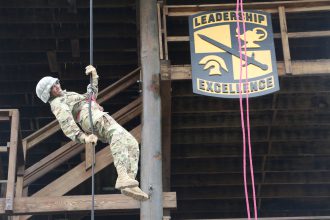Fort Knox, Ky – Second Regiment Cadets mastered the hip rappel seat and the 64 ft. rappel tower.
Before starting the rappel course cadets had to learn how to properly prepare themselves. Sgt. 1st Class Nicholas Evans, University of Arizona, provided instructions on how to properly create the Swiss Seat.
Understanding the Language
Brake Hand- The most dominant hand, usually the writing hand.
Guide Hand – The weaker hand.
Carabiner- Coupling link with a safety closure, used by rock climbers
Tie the Seat.
Place gloves on the guide hand shoulder and the snap link is hooked on the brake hand side pocket.
Grab the rope and match up the free-running ends. Run hands starting from the free ends and continue until they have a bite, a rounded nub.
Place the bite on the guide hand hip side. Reach around and then grab the rear rope and pull it around the front.
At this point one rope should be long. Take the two sides and make an X with the longer rope on top.
Now, using your brake hand you can take the longer rope and pull it through the rope wrapped around your abdomen, around the bellybutton. Repeat this a second time, the rope should now have 5 overhand lace or high spots. Tighten the rope and release.
“The ropes are really tight,” said Issac Olajide, from Oklahoma State University, “right to your skin it hurts, but when you are down you are down.”
Using the brake hand reach under the legs and pull one rope at a time through the back of the waist rope. The tip of the rope should go toward the sky and then lay over the top of the waist rope, facing the center of their back. Repeat the process again, but with the guide hand.
Now tighten the seat. Grab the free running ends of the rope with thumbs facing up, toward the sky. Simultaneously pull the rope down towards the ground while entering a squatting position, continue pulling while returning to a standing position. Repeat this process twice.
“It is pretty tight,” said Jamilah Bryan, Florida International University, “but I know I am secure in it because of how tight it is.”
Once snug you will tie a square knot on your guide hand hip. The square knot is a simple right over left and left over right knot. Secure the square knot using overhand knots, limiting excess. Any excess rope should be stuffed in a pocket.
Add the snap link to the harness. Run the hook of the snaplink along the zipper line. Once hooked onto all three ropes, waist and two overlays, rotate until the locking mechanism is facing the sky.
After this someone should inspect the harness for errors or weaknesses. The Cadets are check twice before every rappel.
Tackling the Fear, Building Confidence
Confidence Committee senior trainer Gary Fortunato has been rappelling for 30 years and admitted he still deals with his fear of heights. He adds that the fear can serve a helpful purpose.
“It slows you down and makes you think about what you are doing,” he said.
During the exercise Cadets will rappel down in two different ways. One with a wall,forcing the Cadets to bounce from a high point to a lower point on the wall. Later, they descend freely with no wall to support them.

Cadets from 2nd Regiment, Advanced Camp, negotiate the Rappel Tower as part of Cadet Summer Training (CST) on June 13, 2018 at Fort Knox, Ky. (Photo by Dakota Patuto)
Cadet James Kitt, from Providence College, said each rappel comes with its own struggle, insisting the wall is a more physical rappel while the free fall is an emotional challenge.
“The wall isn’t harder, it’s just first,” he started. “The wall is harder because you have to worry about your feet but the one that really gets you in your confidence is the free fall, because there’s no place to put your feet.”
For Olajide climbing the tower and preparing to rappel brought the most fear, calling the experience exhilarating. He insisted it does get better.
“Once you start coming down it is easy,” he said.
Bryan admitted that she was scared of heights, but knows that this is something that she has to do.
“I just tell myself I’m not gonna die,” she said. “Believe that nothing is [going] to happen to me if I follow instructions. This is something that is going to test your ability to handle yourself under stress, just take a breather and relax. Overcome your fear.”




